Snowberry is native here. I have been wanting to grow it because I like its white berries. I just found a seedling where it could not stay, so brought it back here. I am very pleased with it, but did not want to share pictures of it as scrawny canned bare twigs. I got these pictures instead.
1. Callicarpa americana, American beautyberry is what compelled me to get pictures of berries for this week. I shared a closeup picture of the first of these berries as they began to ripen more than a month ago, which was about two months later than elsewhere. I do not mind. These are my first, and there are more of them now. Perhaps their berries will ripen on time when they are established within the landscapes. The seedlings, as well as white butterfly ginger and, recently, American holly, were gifts from Our Forest Garden.
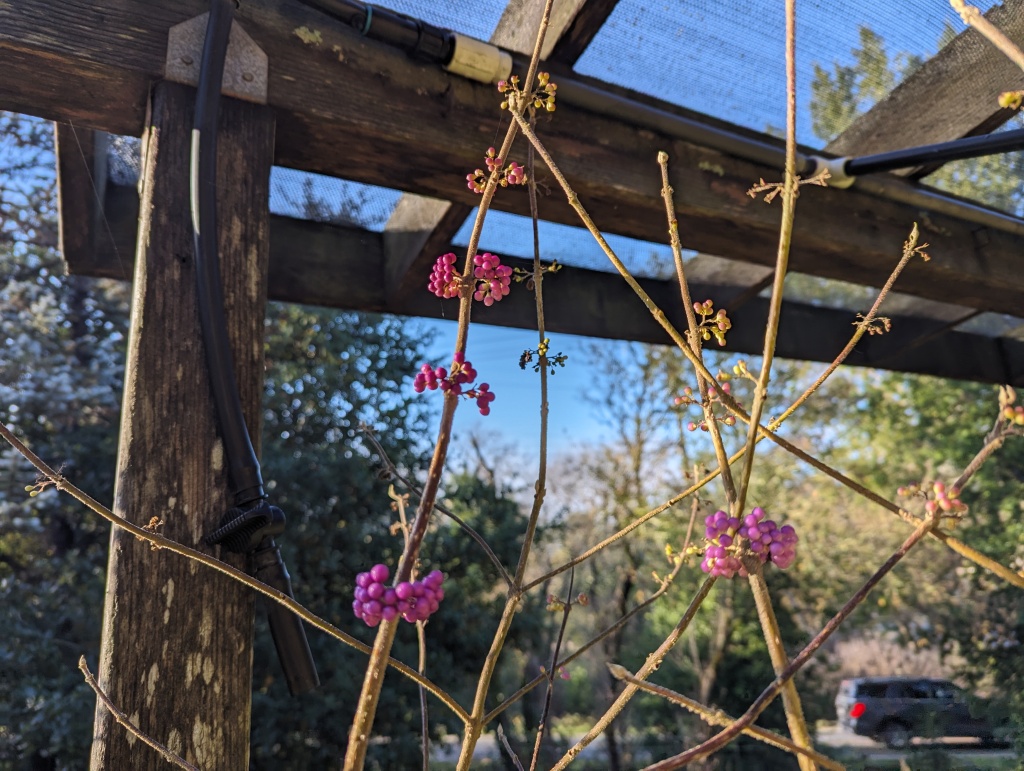
2. Sarcococca ruscifolia, sweet box typically produces very few red berries that typically fall off before turning black. They are both atypically abundant and atypically black now.
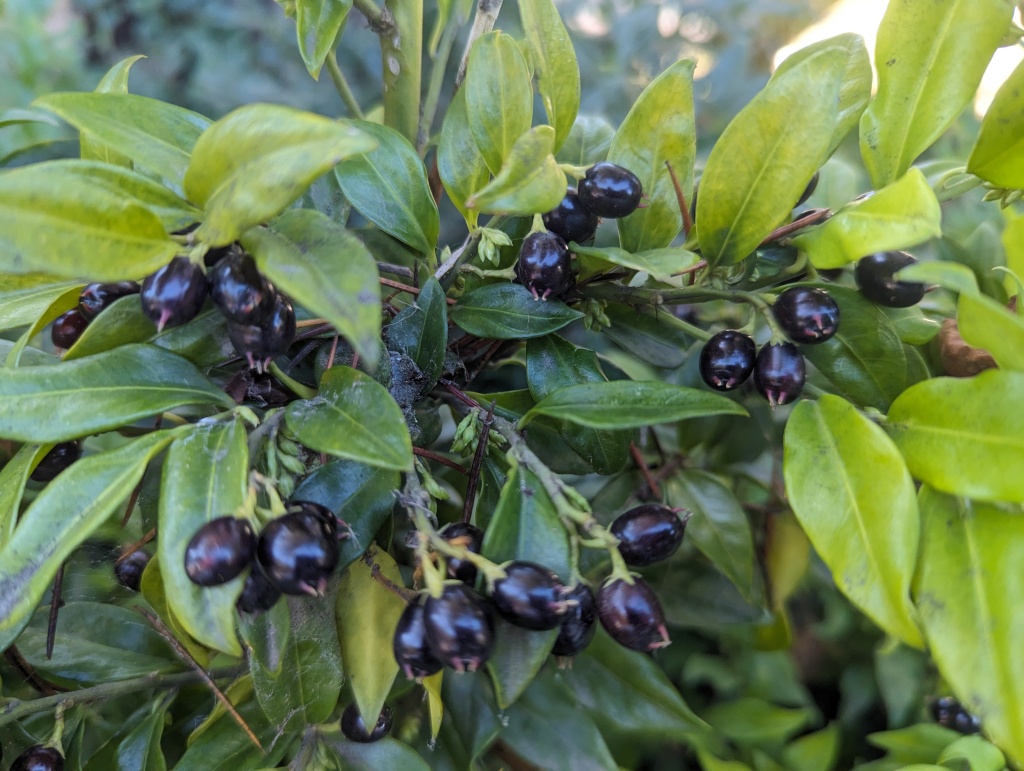
3. Ilex aquifolium, English holly self sows, but most feral specimens seem to be male, or produce only a few berries, in a few sparse clusters. Very few produce clusters like these.
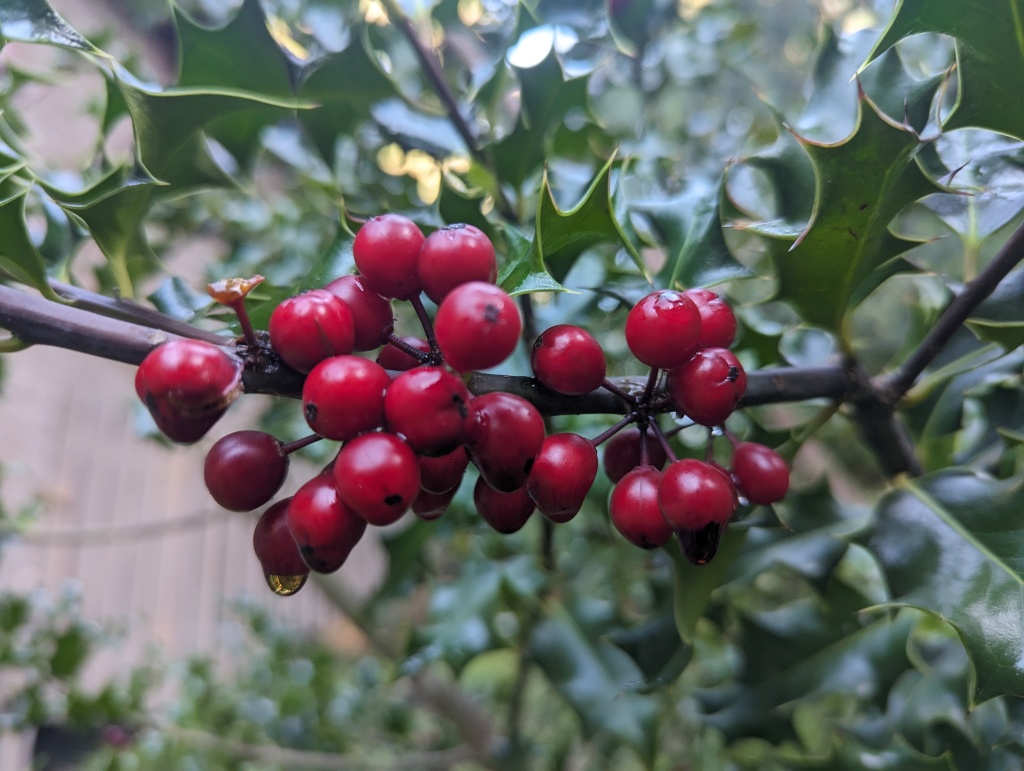
4. Viburnum tinus, laurustinus also self sows. I am not as impressed with it as I am with English holly, but have been learning to appreciate it more, as those in other regions do.
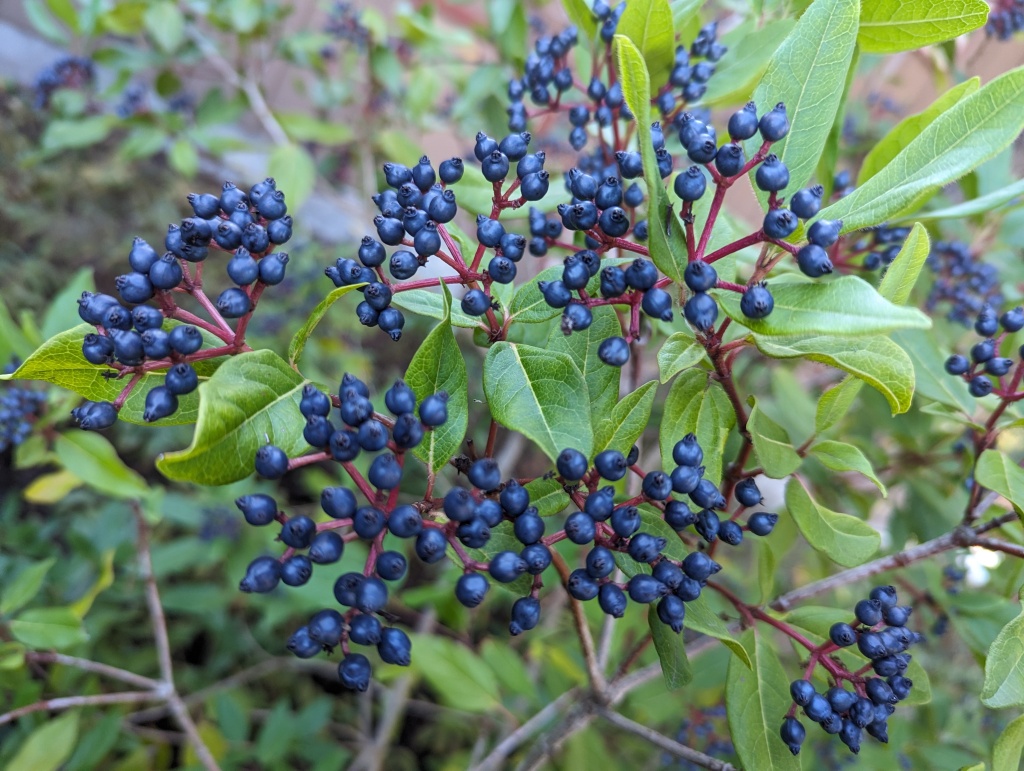
5. Cotoneaster pannosus, silverleaf cotoneaster is naturalized a bit more vigorously. It is not as pretty as I like to think it is. I should retain a few specimens but eradicate the rest.
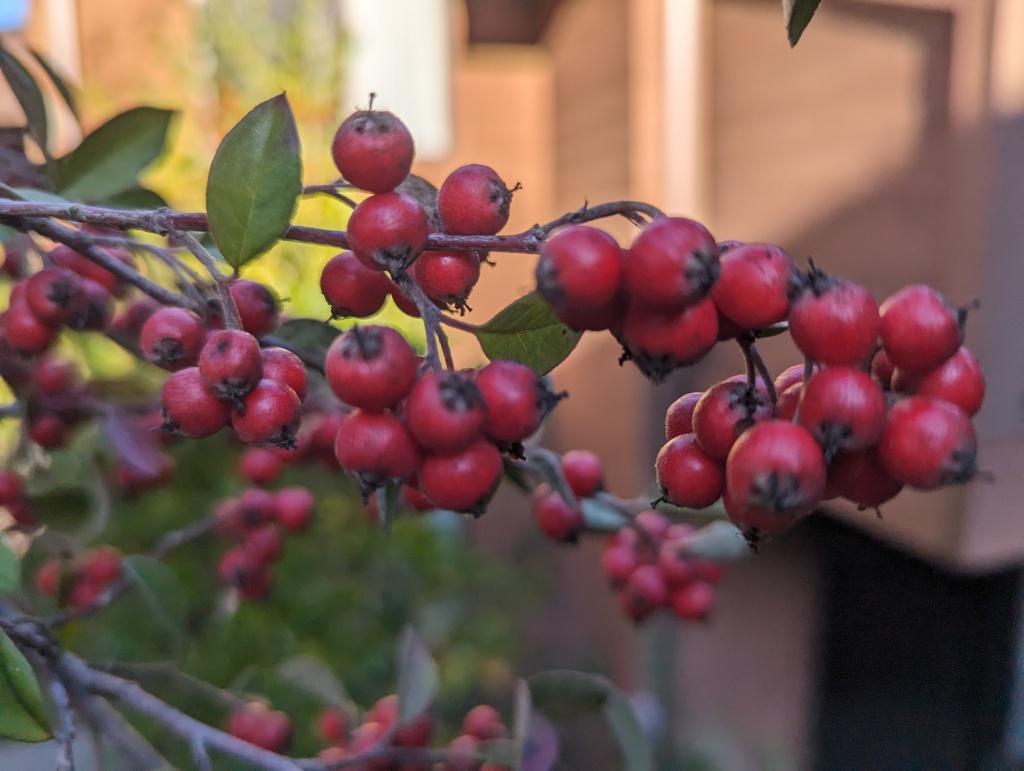
6. Pyracantha coccinea, firethorn is more colorful with similar but with more abundant and glossier berries. Unfortunately, it is also much thornier, so it is no fun to work with.
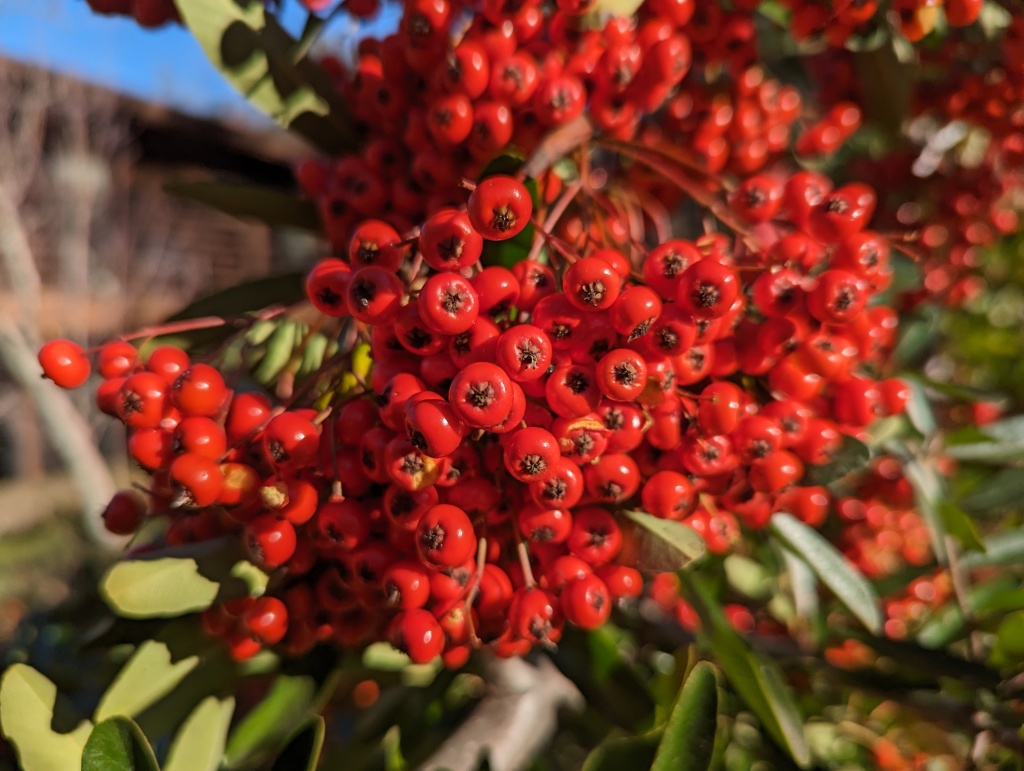
This is the link for Six on Saturday, for anyone else who would like to participate: https://thepropagatorblog.wordpress.com/2017/09/18/six-on-saturday-a-participant-guide/
A bunch of beautiful berries. The holly berries are particularly gorgeous. Happy Christmas to you and Rhoddie
LikeLiked by 1 person
English holly is more of a foliar plant here, since it does not make many berries. I suspect that most specimens are male. (Almost none are planted intentionally, so almost all are feral.) If I were to grow some intentionally, I would take cuttings from those that produce berries.
LikeLike
Merry Christmas (two days ago)!
LikeLiked by 1 person
Lovely berry shots, very festive. Have a brilliant Christmas, hope Rhody will get a special treat!
LikeLiked by 1 person
Rhody gets special treats daily. (Actually, he believes that they are special. There is really nothing special about them, except that his friends give them to him.)
LikeLiked by 1 person
Snowberry used to be really common here and we sold 3 or 4 varieties at the nursery. Then it fell out of favour, stopped selling, and has all but disappeared. I never liked it much.
LikeLiked by 1 person
DId you not like it much because it did not produce many berries? Mine is the simple native sort, so is likely even less impressive than garden cultivars. I intend to at least try it, to determine if I can get it to produce more berries, but will not mind getting rid of it in the future if it fails to impress.
LikeLike
Very pretty selection of colorful berries, which go perfectly with Christmas. I wish you and yours a Merry Christmas, Tony.
LikeLiked by 1 person
Thank you. Berries are not as popular here as they are in climates with colder winters because there is so much other floral color through winter. There is no snow here for them to contrast with.
LikeLiked by 1 person
I have been thinking about planting a snowberry. The purple and red berries you share are lovely and colourful though, and even festive!
LikeLiked by 1 person
Are improved cultivars of snowberry available there? I am familiar with this one only because it is native here. It is not impressive in the wild though, and I sort of doubt that it will be much more impressive in cultivation. I am determined to try it though.
LikeLike
The online nursery I buy from has two cultivars – one called ‘Arvid’ and one called ‘White Hedge’. And then they also sell the one that grows wild here, Symphoricarpos albus. I have no idea if the cultivars are ‘better’ than the one that grows wild here. It gets quite big in the hedgerows. I didn’t realize there are some Symphoricarpos with purple berries too – can’t call them Snowberries surely!
LikeLiked by 1 person
Oh, I had not been impressed with it enough to consider cultivars. I suppose that I should have. I typically prefer wild forms of species, but this is one that I could make an exception for. I do like the white berries, so could grow a cultivar that would make more of them.
LikeLiked by 1 person
It’s fun to see other pretty berries. Beautyberry and pyracantha are wild here, but the others were new to me. They all complement the season perfectly. Merry Christmas to you and Rhody!
LikeLiked by 1 person
Thank you. Pyracantha self sows somewhat here, and the few specimens that I work with happen to be feral. However, I am not convinced that it is actually naturalized very far from cultivation. I had been wanting beautyberry for a while because it seems to be so familiar in most parts of America. These came from Our Forest Garden in Williamsburg in Virginia.
LikeLiked by 1 person
Good theme for today’s six. After the New Year I’ll snip off the red berries from the three nandina shrubs I allow to live for the sake of their texture and Christmas time how.
LikeLiked by 1 person
Thank you. It was not planned. I wanted to show off the beautyberry though. I like the English holly also, since only a few specimens develop so many berries.
LikeLike
I love snowberry and it seems to love where it’s growing, seeings as it’s spreading all over. Beautiful berries are perfect for the season – Merry Christmas Tony!
LikeLiked by 1 person
Thank you. Is your snowberry the same Symphoricarpos albus that is native here? It is always so wimpy here.
LikeLiked by 1 person
Likely eh? I remember it also as a child, on the west coast…I don’t consider it wimpy tho since it’s one of the few shrubs that will thrive in dry semishade..a dense thicket is quite attractive in summer.
LikeLiked by 1 person
That is what others who are familiar with it in other regions say about it. I should look for it in the Pacific Northwest. In this region, they look like shabby and shrubby honeysuckle. Most stays very low. Berries are rare. I intend to prune what I got, to see if it invigorates it like elderberry.
LikeLiked by 1 person
Nice berry collection. I like that Viburnum – not familiar with it. Same with the Cotoneaster, they always look dreadful in the south due to humidity. Merry Christmas!
LikeLiked by 1 person
Thank you. Everyone else seems to be familiar with the Viburnum tinus, and appreciates it more than I do. That is why I am trying to appreciate it more. It does seem to prefer drier situations though, and gets shabby in riparian situations. It does not seem like a species that would perform well in England, where it seems to be popular.
LikeLiked by 1 person
There are a couple of popular Viburnum here, landscapers favorites that grow fast and are put in places they are too big for. V. suspensum and V. odoratissimum. I don’t have any.
LikeLiked by 1 person
This seems to be one of the few places where the genus is unpopular. I see more in the Pacific Northwest, but they are healthier. A few old specimens of Viburnum davidii live in an old landscape in town, but look icky. A friend lived there a few years ago. I should have cut them to the ground while I had the chance. They might regenerate better.
LikeLiked by 1 person
ugh, I hate those, they were very popular in Atlanta for a while and then all died.
LikeLiked by 1 person
So, I am not the only one who is not impressed by them. It was never ‘very’ popular here, but I can not imagine why it was even slightly popular when it was.
LikeLiked by 1 person